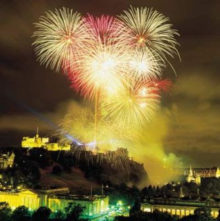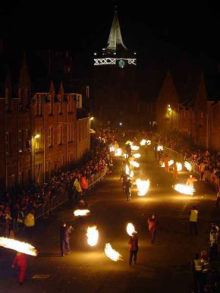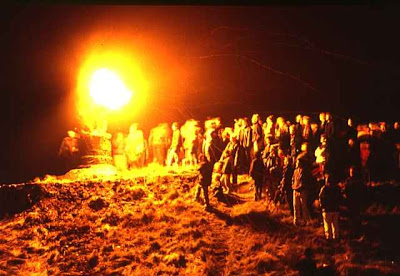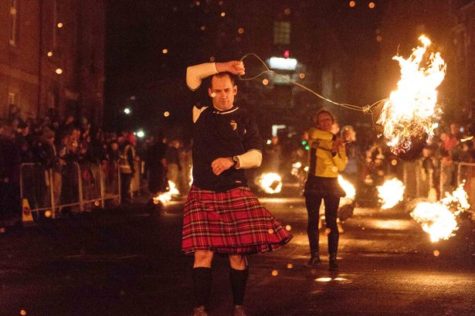Bonfires
To celebrate the New Year fireballs swing in Stonehaven, Scotland.
The ceremony consists of mainly local people of all ages swinging flaming wire cages, around their heads. Each cage is filled with combustible material (each swinger has their own recipe) and has a wire handle two or three feet long, this keeps the flames well away from the swinger, but spectators can be vulnerable! At the end of the ceremony, the fireballs are tossed into the bay.
The event starts at midnight and is watched by thousands. The idea behind the ceremony is to burn off the bad spirits left from the old year so that the spirits of the New Year can come in clean and fresh.
From current research the ceremony would seem to go back from a hundred to a hundred and fifty years, but it could easily be much older.
The ceremony today lasts only around twenty to thirty minutes but in the past it could last an hour or more. Then, some of the swingers would swing their fireball for a few yards and then stop outside a house that was occupied by someone that they knew. They would drop their fireball at the curbside and pop in for their ‘New Year’! After a while they would come out, pick up their ‘ball’ and swing on down to the next house, and so on. As quite a number of the swingers would have had many relatives and friends staying in area it could take some time to get from one end of the street to the other!
In the early years, according to the newspaper reports, it would seem that it was mainly the male youths of the older ‘fisher’ town that were involved in the custom but once into the sixties the newspaper reports are of older men and women being involved as well.
 In Scotland, the last day of the year is called Hogmanay, the word children use to ask for their traditional present of an oatmeal cake (which is why this is also called Cake Day). Traditionally, children in small towns would wander about town, particularly in the more affluent neighborhoods, visiting their neighbors of the better class, crying at their doors, “Hogmanay!” or sometimes the following rhyme:
In Scotland, the last day of the year is called Hogmanay, the word children use to ask for their traditional present of an oatmeal cake (which is why this is also called Cake Day). Traditionally, children in small towns would wander about town, particularly in the more affluent neighborhoods, visiting their neighbors of the better class, crying at their doors, “Hogmanay!” or sometimes the following rhyme:
Hogmanay, trollolay,
Gie’s of your white bread
and none of your gray!
In obedience to which call, they are served each with an oaten cake. Immediately after midnight it is traditional to sing Robert Burns’ “Auld Lang Syne”
“Should auld acquaintance be forgot and never brought to mind?
Should auld acquaintance be forgot and auld lang syne
For auld lang syne, my dear, for auld lang syne,
We’ll take a cup o kindness yet, for auld lang syne.”
Fireworks and fire festivals are still common across Scotland, as are parties and celebrations of all kinds. There are many customs, both national and local, associated with Hogmanay. The most widespread national custom is the practice of ‘first-footing’ which starts immediately after midnight. This involves being the first person to cross the threshold of a friend or neighbor and often involves the giving of symbolic gifts such as salt (less common today), coal, shortbread, whisky, and black bun (a rich fruit cake) intended to bring different kinds of luck to the householder. Food and drink (as the gifts) are then given to the guests.
This may go on throughout the early hours of the morning and well into the next day (although modern days see people visiting houses well into January). The first-foot is supposed to set the luck for the rest of the year. Traditionally, tall dark men are preferred as the first-foot. And of course, the entire spirit of a Hogmanay party is to welcome both friends and strangers with warm hospitality and of course lots of kissing all-around!
It’s believed that Hogmanay originated with the invading Vikings who celebrated the passing of the winter solstice with much revelry, but the roots of Hogmanay perhaps reach back to the celebration of the winter solstice among the Norse, as well as incorporating customs from the Gaelic New Year’s celebration of Samhain.
In Rome, winter solstice evolved into the ancient celebration of Saturnalia, a great winter festival, where people celebrated completely free of restraint and inhibition. The Vikings celebrated Yule, which later contributed to the Twelve Days of Christmas, or the “Daft Days” as they were sometimes called in Scotland. The winter festival went underground with the Protestant Reformation and ensuing years, but re-emerged near the end of the 17th century
Each area of Scotland often developed its own particular Hogmanay ritual.
 An example of a local Hogmanay custom is the fireball swinging that takes place in Stonehaven, Aberdeenshire in north-east Scotland. This involves local people making up ‘balls’ of chicken wire filled with old news paper, dried sticks, old cotton rags, and other dry flammable material up to a diameter of 60 cm. Each ball has approximately 1 m of wire, chain or nonflammable rope attached.
An example of a local Hogmanay custom is the fireball swinging that takes place in Stonehaven, Aberdeenshire in north-east Scotland. This involves local people making up ‘balls’ of chicken wire filled with old news paper, dried sticks, old cotton rags, and other dry flammable material up to a diameter of 60 cm. Each ball has approximately 1 m of wire, chain or nonflammable rope attached.
As the Old Town House bell sounds to mark the new year, the balls are set alight and the swingers set off up the High Street from the Mercat Cross to the Cannon and back, swinging their burning ball around their head as they go for as many times as they and their fireball last. At the end of the ceremony any fireballs that are still burning are cast into the harbor.
Many people enjoy this display, which is more impressive in the dark than it would be during the day. As a result large crowds flock to the town to see it, with 12,000 attending the 2007/2008 event. In recent years, additional attractions have been added to entertain the crowds as they wait for midnight, such as fire poi, a pipe band, street drumming and a firework display after the last fireball is cast into the sea. The festivities are now streamed live over the Internet.

Another example of a pagan fire festival is the burning the clavie which takes place in the town of Burghead in Moray.In the east coast fishing communities and Dundee, first-footers used to carry a decorated herring while in Falkland in Fife, local men would go in torchlight procession to the top of the Lomond Hills as midnight approached. Bakers in St Andrews would bake special cakes for their Hogmanay celebration (known as ‘Cake Day’) and distribute them to local children.
In Glasgow and the central areas of Scotland, the tradition is to hold Hogmanay parties involving singing, dancing, the eating of steak pie or stew, storytelling and consumption of copious amounts of alcohol, which usually extend into the daylight hours of January 1.
Institutions also had their own traditions. For example, among the Scottish regiments, the officers had to wait on the men at special dinners while at the bells, the Old Year is piped out of barrack gates. The sentry then challenges the new escort outside the gates: ‘Who goes there?’ The answer is ‘The New Year, all’s well.’
An old custom in the Highlands, which has survived to a small extent and seen some degree of revival, is to celebrate Hogmanay with the saining (Scots for ‘protecting, blessing’) of the household and livestock. This is done early on New Year’s morning with copious, choking clouds of smoke from burning juniper branches, and by drinking and then sprinkling ‘magic water’ from ‘a dead and living ford’ around the house (‘a dead and living ford’ refers to a river ford which is routinely crossed by both the living and the dead). After the sprinkling of the water in every room, on the beds and all the inhabitants, the house is sealed up tight and the burning juniper carried through the house and byre.
The smoke is allowed to thoroughly fumigate the buildings until it causes sneezing and coughing among the inhabitants. Then all the doors and windows are flung open to let in the cold, fresh air of the new year. The woman of the house then administers ‘a restorative’ from the whisky bottle, and the household sits down to their New Year breakfast.
Collected from various sources




